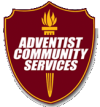AY Honors/Identifying Community Needs/Answer Key
1. Jesus understood the needs of his community because he went out and saw their needs. Read Matthew 9:35-38.
Then Jesus went about all the cities and villages, teaching in their synagogues, preaching the gospel of the kingdom, and healing every sickness and every disease among the people. But when He saw the multitudes, He was moved with compassion for them, because they were weary and scattered, like sheep having no shepherd. Then He said to His disciples, “The harvest truly is plentiful, but the laborers are few. Therefore pray the Lord of the harvest to send out laborers into His harvest.”
2. Select an urban or suburban neighborhood, a small town or a rural region on which to focus in the completion of the requirements for this honor.
Because this is your community, you should have some idea of where the greatest needs are. Match the size of the area on which you focus with the resources you have available, but don't forget that the Lord will provide for His own work.
3. Compile a file folder of information on the selected community, which could include:
Most of this information can be gathered from the U.S Census Bureau at http://factfinder2.census.gov/faces/nav/jsf/pages/index.xhtml
Just go there and enter a zip code.
a. A map of the area
You can use a printed atlas or an online map service such as
b. A demographic profile
A demographic profile is a breakdown of the people in the community based on age, sex, race, income levels, employment status, average household size, etc.
c. Public health statistics
This includes the rates of:
- Birth
- Death
- Divorce
- Marriage
- Fetal death
This data is available from your state's Department of Health and Human Services, though it may be difficult to track down. Try plugging in the name of your state plus "public health statistics" into a search engine.
d. Economic indicators
Economic indicators include employment rates, income levels, occupations, number of businesses vs residences, etc.
e. Housing information
Housing information includes data such as the percentage of houses units that are apartments, single family homes, lot size, and whether the home is rented or owned. Single-family homes on large lots indicates a higher level of income.
f. Environment and transportation
Environmental data includes such things as the amount of land set aside for conservation or public access. Transportation includes figures such as the number of people who drive to work alone, carpool, walk, use public transportation, or work from home. It also includes the availability of public transportation (subway, bus service, etc).
4. With an adult sponsor, take an awareness walk of or drive around a specific part of the selected community with the goal in mind of seeing human needs. List all of the needs you see such as yards and public areas that could be cleaned up, litter that could be picked up, lonely or aged people that could be helped, low-income families with children that could be assisted, etc.
This requirement will have to be planned we ahead of its execution. You will need signed permission slips for all the Pathfinders as well as a plan for transportation. Transportation could be as simple as walking around the neighborhood outside your church, or it could mean loading everyone up into vehicles and driving around.
When you are out looking around, here are some things to note:
- Homelessness
- Tents pitched in public places, in wooded areas along roadsides, etc
- Disheveled people sitting on park benches, etc
- People holding signs saying "Homeless" at street corners
- Panhandlers
- Unattended children
- Houses in disrepair
- Broken windows
- Houses needing paint
- Overgrown lawns
- Litter
- Graffiti
- Unmaintained parks

